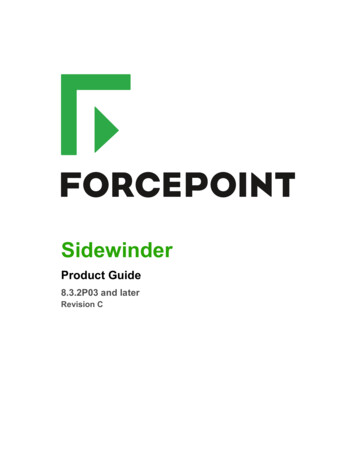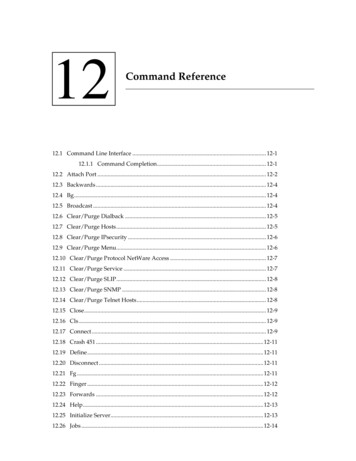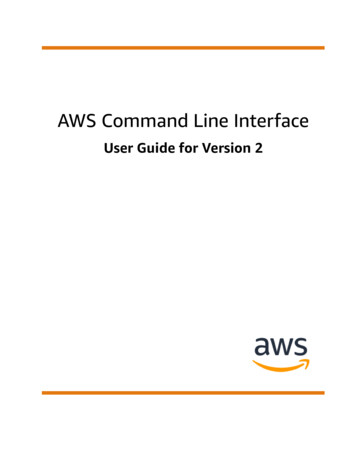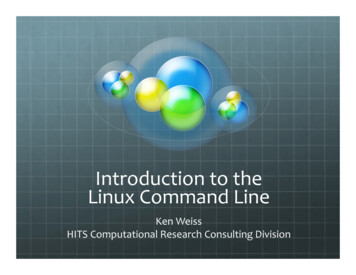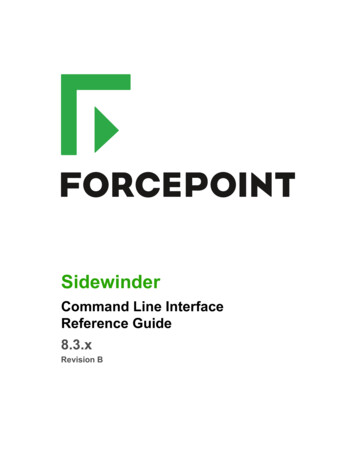
Transcription
SidewinderCommand Line InterfaceReference Guide8.3.xRevision B
Table of contents1 About the command line interface. 3About the cf command.3Integrated manual pages. 32 Log on at the command line interface.53 Frequently used commands. 6Administrator accounts.6Anti-virus.6Audit.7Configuration backups.8DNS. 8Downloads. 9Emergency maintenance mode (EMM). 9File system. 10Firewall self-diagnostics. 10General cf commands.11High Availability. 11Interfaces. 11Licensing.12Manual pages.12McAfee EIA. 13Networking.13NTP.14Policy. 14Routing. 15Security zones and groups. 16sendmail. 16Shutdown.17Software management. 17System.18tcpdump. 19Technical support. 19Text editors and viewers.20Type Enforcement. 20VPN. 204 Available cf areas. 222
About the command line interfaceIf you are experienced with UNIX, you can use the Forcepoint Sidewinder command line interface to configurethe firewall and perform troubleshooting.The command line interface supports many firewall-specific commands as well as standard UNIX commands. Forexample, the cf command performs a wide range of firewall configuration tasks.You can access the command line interface using these methods: Locally attached consoleSSHTelnetFor more information about these methods, see the Forcepoint Sidewinder Product Guide.About the cf commandThe cf (configure firewall) command configures various areas such as rules, zones, and interfaces. You can usethe cf command as an alternative to the Admin Console to perform most administration tasks.To accomplish a task using cf, combine the cf area with the appropriate command, optional arguments, andoptional keys. For more information, see General cf commands.Example: cf zone query displays the configured security zones.Tip: You can use the cf command in scripts to automate repetitive configuration tasks or to makeconfiguration changes when the Admin Console is not available.The cf commands and keys ignore dashes, underscores, and capital letters. You can shorten most commandsand keys.Example: These commands return the same output:cf policy query dest zone externalcf pol q destz externalNote: Key values — text to the right of the equals sign — might not ignore dashes, underscores,and capital letters. Key values might be shortened if it represents an enumeration such as anobject name.To view a list of available cf areas, enter:cf -hRelated referenceGeneral cf commands on page 11Use these commands to view cf man pages and control the behavior of cf commands.Integrated manual pagesThe command line interface includes integrated manual (man) pages for most commands.To view a man page, type man followed by the name of a command, then press Enter.About the command line interface 3
Example: man pingThe man page for cf provides a full description of all areas available in the cf command and the optionsassociated with each area. To view the man page for the cf command, enter: man cfTo view the man page for a specific cf area, enter:man cf areaExamples: man cf policy man cf interfaceTo display all commands related to a specific command, enter:man -k commandAbout the command line interface 4
Log on at the command line interfaceYou must run the srole command before you can use most commands.1.2.3.4.At the logon prompt, type your user name, then press Enter. The Password prompt appears.Type your password, then press Enter. The User domain prompt appears:firewall name:User {1} %Enter the srole command to change to the Admn domain.When you are finished, enter the exit command to return to the User domain.Log on at the command line interface 5
Frequently used commandsThis section lists basic UNIX commands and commands that are specific to Sidewinder. For additional information about a command, refer to the man page.For additional troubleshooting information, see the Forcepoint Sidewinder Product Guide.Administrator accountsUse these commands to manage administrator accounts.Table 1: Administrator account commandsCommandDescriptionman cf adminuserDisplays the man page for cf adminuser.cf adminuser add username usernamepassword password role admin directory /home/usernameCreates an administrator account.cf adminuser add username usernamepassword password role adminro directory /home/usernameCreates a read-only user account.cf adminuser delete username usernameDeletes an administrator account.cf adminuser modify user usernamepassword newpasswordChanges the password for an administrator account.cf adminuser queryDisplays the administrator user database.Note: The adminro role is available forfirewalls at version 8.3.2 and later.Anti-virusUse these commands to manage the anti-virus feature.Table 2: Anti-virus commandsCommandDescriptionman cf antivirusDisplays the man page for cf antivirus.cf antivirus queryDisplays the anti-virus configuration.cf antivirus versionDisplays the version of the anti-virus engine anddetection definition (DAT) files.cf daemond restart agent virus-scanRestarts the anti-virus engine.cf antivirus applyavpatch patch patch nameInstalls an anti-virus engine patch without restarting thefirewall.cf antivirus downloadDownloads the latest DAT files.Frequently used commands 6
AuditUse these commands to configure and view audit.Table 3: Audit commandsCommandDescriptioncf acl set loglevel [1–4]Configures the audit output level for rules to control what is logged:1 — Fatal errors only2 — [Default] Fatal errors, major errors, and denied rules3 — Fatal errors, major errors, denied rules, and allowed rules4 — Everything (for troubleshooting only)Note: See the Policy area for commands about rules.acat /var/tmp/audit.txtWrites the contents of the binary /var/log/audit.raw file to the ASCII textfile /var/tmp/audit.txt.acat /var/log/Writes the contents of the specified compressed binary audit file to theaudit.raw.time1.time2.gz /var/tmp/ ASCII text file /var/tmp/audit.txt.audit.txtacat –kShows all audits in real time.acat acls –dShows audits for policy denies in real time.acat acls –aShows audits for policy allows in real time.acat –cDisplays all the possible options for a sacap filter.showaudit –kpShows netprobe audits in real time.showaudit –kH X.X.X.XShows audits pertaining to the IP address X.X.X.X in real time.rollaudit –R d –wRolls log files (such as audit.raw).cf daemond enable agent auditdbdEnables the audit server. Reports will not generate until this server isenabled.cf usage show type report namehours [1–24]Displays a usage report for the specified number of hours.cf usage show type report namedays [1–180]Displays a usage report for the specified number of days.man cf usageDisplays the man page for cf usage. This includes the list of usagereports.cf passport listDisplays the currently issued Passports.blackhole dumpLists IP addresses that are currently blackholed by audit responses andIPS responses.Related referencePolicy on page 14Frequently used commands 7
Use these commands to troubleshoot policy issues.Configuration backupsUse these commands to create and restore configuration backups.Table 4: Configuration backup commandsCommandDescriptioncf config backup loc local filename filenamekey passwordSaves a configuration backup in the local /var/backups/repository directory.cf config backup loc USB filename filenamekey passwordSaves a configuration backup to a USB drive.cf config backup loc remote address destinationuser username password password key passwordSaves a configuration backup to a remote host usingSCP.cf config restore loc location filename filenamekey passwordRestores a configuration backup; specify local, remote,or USB.cf config compare to filename1 from filename2Displays the differences between two configurationbackup files.cf config getinfo location local/usb filename filenameDisplays meta-information about the specifiedconfiguration backup.DNSUse these commands to configure and troubleshoot DNS.Table 5: DNS commandsCommandDescriptioncf dns queryDisplays the current DNS server configuration.cf dns statusDisplays the status of the firewall-hosted DNS servers.cf daemond restart agent namedinternetRestarts the Internet DNS server.cf daemond restart agent namedunboundRestarts the unbound DNS server.cf dns reloadReloads DNS zone and configuration files.cf dns dumpdbWrites the DNS database in memory to the file specified by named.conf.cf dns traceEnables debug tracing to /var/run/named.run.i and /var/run/named.run.u.cf dns notraceDisables tracing.hostnameDisplays the firewall host name.named-checkconf /etc/named.conf.[u/i]Checks DNS configuration file syntax.Frequently used commands 8
CommandDescriptionnamed-checkzone zone /etc/namedb.[i/u]/file.dbChecks a zone file for correct syntax.dig host.domain.tldQueries the default DNS server information about host.domain.tld.dig @X.X.X.X host.domain.tldQueries the DNS server at X.X.X.X for information about host.domain.tld.dig zone MXQueries for the MX record of the specified zone.dig –x X.X.X.XQueries for the PTR record of the specified IP address.tail –f /var/log/daemon.logDisplays logs pertaining to DNS in real time.tail –f /var/log/daemon.log grepnamedDisplays logs for named in real time.less /etc/named.conf.[i/u]Views the configuration file for Internet/unbound DNS.ls /etc/namedb.[i/u]Lists the directory containing Internet/unbound zones (.db).DownloadsUse these commands to download the application database, Geo-Location database, and IPS signatures.Table 6: Download commandsCommandDescriptioncf appdb downloadDownloads the latest application database.cf appdb versionDisplays the current version of the application database.cf appdb rollbackReverts to the previously downloaded application database.cf geolocation downloadDownloads the latest Geo-Location database.cf geolocation versionDisplays the current version of the Geo-Location database.cf ips downloadDownloads IPS signatures.cf message loadDownloads the latest messages from Forcepoint.cf message versionDisplays the current version of the loaded messages from Forcepoint.cf message listDisplays current messages from Forcepoint.Emergency maintenance mode (EMM)Use these commands to enter and use emergency maintenance mode.Table 7: Emergency maintenance mode commandsCommandDescriptionshutdown nowEnters emergency maintenance mode (EMM).cf policy restore console accessRestores default Admin Console and Login Console rules when you arelocked out of the firewall.Frequently used commands 9
CommandDescriptionless /var/run/dmesg.bootDisplays the log of system messages from the kernel.mount –aMounts all file systems in /etc/fstab.fsckChecks all file systems listed in /etc/fstab.File systemUse these commands to display free space and find files in the file system.Table 8: File system commandsCommandDescriptiondf –hDisplays free disk space.du –a / sort –nr moreDisplays files and directories sorted from largest to smallest.find / –type f –name “*name*”Finds files that include the text name in the file name.find / –type f –name “*.core*”Finds application core files.ls /var/log/crashDisplays kernel crash files (vmcore. n .gz).Firewall self-diagnosticsUse these commands to manage the firewall self-diagnostics feature.Table 9: Firewall self-diagnostics commandsCommandDescriptioncf monitord queryDisplays the current monitord configuration.cf monitord set hot process threshold percentageSets the CPU usage threshold for processes.If the process reaches that value, it is considered a hotprocess.cf monitord set hot process audit on/offWhen enabled, generates audit or send an alertwhen a process goes hot over the configuredhot process audit duration.cf monitord set hot process audit duration minutesSets duration to wait before generating audit orsending an alert about the hot process.cf monitord set hot process diagnostic on/offWhen enabled, restarts the hot process and generatesdiagnostic if the process continues to be hot over theconfigured hot process diagnostic duration.cf monitord sethot process diagnostic duration minutesSets duration to wait before generating diagnostics andrestarting the hot process.Frequently used commands 10
General cf commandsUse these commands to view cf man pages and control the behavior of cf commands.Table 10: cf commandsCommandDescriptionman cfDisplays the man page for cf.man cf areaDisplays the man page for the specified cf area.cf area commandRuns the specified command.cf –i ticketID area commandMarks the changes caused by the command with the specified ticket ID.cf area queryDisplays the current configuration of the specified cf area.cf –option area queryModifies the output of the query command based on the specified option: d delimiter — Displays the output on a single line, separating eachelement using the specified delimiter.J — Displays the output on a single line, which is useful for piping it toanother command, such as grep.K key1,key2 — Displays output for the specified keys only.T — Formats the output in a table that contains one column per key.High AvailabilityUse these commands to configure and troubleshoot High Availability.Table 11: High Availability commandsCommandDescriptionman cf clusterDisplays the man page for cf cluster.cf cluster failover statusDisplays status of the failover daemon.cf cluster statusDisplays the current registration and daemon status of the cluster.cf cluster queryDisplays peer reservations and global cluster settings.tcpdump –pRuns tcpdump on a load-sharing High Availability cluster.InterfacesUse these commands to configure network interfaces.Table 12: Network interface commandsCommandDescriptionman cf interfaceDisplays the man page for cf interface.cf interface qDisplays the network interface and NIC configuration.Frequently used commands 11
CommandDescriptioncf interface modify name name addresses IP1/netmask,IP2/netmaskModifies the IP addresses assigned to the specifiedinterface.cf interface modify name name zone zonenameAssociates the interface with the specified zone.cf interface swap hwdevice NICname1swap hwdevice NICname2Swaps configuration settings between two NICs,including the IP address, zones, aliases, and otherconfigured attributes associated with the NIC.cf interface modify entrytype nic name NICnameiftype mediatypeSets the media type for the NIC, such as autoselect or1000baseTX.LicensingUse these commands to view and configure the firewall license.Table 13: Licensing commandsCommandDescriptioncf license featuresPrints a list of the currently licensed features.cf license qShows the current license configuration.cf license getRetrieves master key based on license configuration.cf license systemIDDisplays the system IDs available to be used for license activation. Onlyone system ID can be used to activate.cf license read file filenameReads the license from a file for manual activation.Manual pagesUse these commands to find and view manual pages.Table 14: Manual page commandsCommandDescriptionman commandDisplays the man page for the specified command.man cf commandDisplays the man page for the specified cf area.man –k termLists all man pages that include the specified term.Note: This command does not return cf commands.Frequently used commands 12
McAfee EIAUse these commands to troubleshoot McAfee Endpoint Intelligence Agent (McAfee EIA).Note: The McAfee EIA commands are available for firewalls at version 8.3.2 and later. If you areusing McAfee Network Integrity Agent with a firewall at version 8.3.1 or earlier, see the man pagefor cf nia.Table 15: McAfee EIA commandsCommandDescriptioncf eia set enabled yes/nodeploy mode static/dynamicEnables or disables the McAfee EIA feature. Deployment mode is staticor dynamic.cf eia queryDisplays the McAfee EIA configuration.cf eia query allDisplays the configuration settings and entries made on the discovery andexecutable lists.cf eia import executablefilename filenameAllows the classification executable entries to be imported from a file.cf eia query discovery listIn dynamic deployment, displays the entries in the discovery lists.cf eia query executable listDisplays the entries in the executable classification lists.cf eia purge discovery listRemoves all entries from the host discovery lists.cf eia purge executable listRemoves all entries from the executable classification lists.cf eia flush gti cacheRemoves all McAfee Global Threat Intelligence (McAfee GTI) filereputation entries from the local firewall cache.NetworkingUse these commands to view networking information and troubleshoot networking problems.Table 16: Networking commandsCommandDescriptionnetstat –inDisplays statistics for network interfaces.Tip: See man netstat for additional flags.netstat –I interface –w 5Shows live statistics for the specified network interface every fiveseconds.ifconfig –aShows current network interface parameters.ifconfig bridge0 etherShows the MAC address table for the transparent interface, if configured.cf interface qDisplays the network interface and NIC configuration.ping X.X.X.XPings the specified IP address from the firewall.arp –aShows ARP tables.Frequently used commands 13
CommandDescriptionTip: To add a static ARP entry, see man arp.conf.arp –d hostnameClears the specified ARP entry from the firewall.NTPUse these commands to configure and troubleshoot the NTP (Network Time Protocol) server.Table 17: NTP commandsCommandDescriptioncf ntp queryDisplays the NTP configuration.cf daemond restart agent ntpRestarts the NTP server for the specified zone.ntpdate –bu time serverIPForces immediate synchronization with the specified NTP server.tcpdump –npi interface udp port 123 Captures NTP traffic (UDP port 123) on the specified network interface.ntpqStarts the special NTP query program.Note: See man ntpq for details.PolicyUse these commands to troubleshoot policy issues.Table 18: Policy commandsCommandDescriptionman cf policyDisplays the man page for cf policy.cf policy q lessDisplays the access control rules.cf appdb listDisplays the applications in the application database that is currentlyloaded.cf application queryDisplays custom applications.cf appgroup queryDisplays application groups.cf geolocation listDisplays Geo-Location countries and corresponding country codes.cf server statusDisplays which servers are running.cf agent queryDisplays the agents and their global properties.cf appfilter queryDisplays all Application Defenses.ipfilter –vDisplays the ipfilter database currently used by the kernel.cf policy reloadReloads the ipfilter database being used by the kernel.Frequently used commands 14
CommandDescriptionCAUTION: Active sessions will be dropped.cf policy repairRepairs the policy database.cf policy restore console accessRestores default Admin Console and Login Console rules when you arelocked out of the firewall.Tip: If you are unable to log on to your firewall, run thiscommand from emergency maintenance mode. SeeEmergency maintenance mode (EMM).cf policy export filenameWrites the current policy configuration to a tab-delimited file that can beimported into Microsoft Excel.cf ssl query table ruleDisplays the SSL rules.Related referenceEmergency maintenance mode (EMM) on page 9Use these commands to enter and use emergency maintenance mode.RoutingUse these commands to configure and troubleshoot static routes.Table 19: Routing commandsCommandDescriptionroute –n get destinationDisplays the gateway used to reach the specified destination.route –n get defaultDisplays the default route.traceroute –n destinationDisplays the route packets take to reach the specified destination.Tip: For IPv6 addresses, use traceroute6.netstat –nrDisplays the routing tables, including static routes and learned routes.Zones are identified by index.cf route statusDisplays the routing tables, including static routes and learned routes.Zones are identified by name.cf route queryDisplays the configured static routes.cf route add route host/maskgateway gatewayAdds a static route.cf route delete route host/maskDeletes the specified route.Frequently used commands 15
Security zones and groupsUse these commands to manage zones and zone groups.Table 20: Zone commandsCommandDescriptioncf zone queryDisplays zone configuration.cf zone delete name nameDeletes the specified zone.Note: A zone cannot be deleted if it isreferenced by any active policy.cf zone add name name modes 0–63Adds a new zone.Note: For information about modes, seeman cf zone.regionDisplays the zone indexes.cf zone modify name name newname newnameChanges the name of the specified zone.cf zonegroup queryDisplays zone group configuration.cf zonegroup delete name nameDeletes the specified zone group.Note: A zone group cannot be deleted if itis referenced by any active policy.cf zonegroup add name name members zone1,zone2 Creates a zone group.cf zonegroup modify name namemembers zone1,zone2,zone3Adds zones to a zone group.sendmailUse these commands to troubleshoot sendmail issues.Table 21: sendmail commandsCommandDescriptioncf sendmail flush queue zoneFlushes the mail queue for the specified zone.cf sendmail rebuildRebuilds the sendmail database files.cf daemond restart agent sendmailRestarts the sendmail server.cf server status sendmailDisplays if sendmail is running and in which zones.mailqDisplays the mail queues.tail –f /var/log/maillogDisplays the mail log in real time.netstat –na grep LISTEN grep 25Displays listens on port 25.Frequently used commands 16
CommandDescriptionls /var/spool/mqueue.#Displays directory for queued mail.newaliasesRebuilds the /etc/aliases file.telnet X.X.X.X 25Connects to a mail server IP address on port 25 to testSMTP connectivity.pss sendmail grep -c sendmailDisplays the number of sendmail processes running.pss sendmailDisplays if sendmail is accepting connections.ShutdownUse these commands to shut down the firewall.Table 22: Shutdown commandsCommandDescriptionshutdown –r nowRestarts the firewall immediately.shutdown –h nowHalts the firewall immediately.shutdown –p nowTurns off the appliance immediately.shutdown –s now 30Schedules a soft shutdown on a load-sharing firewall to direct allconnections to the other firewall. The firewall will shut down in 30 minutes.shutdown nowCauses the firewall to enter emergency maintenance mode.Software managementUse these commands to manage software packages.Table 23: Software management commandsCommandDescriptionman cf packageDisplays the man page for cf package.cf package listDisplays a summary of installed and loaded software packages.cf package load source sourcepackages package nameDownloads the specified package.cf package installpackages package nameInstalls the specified package.cf package uninstallpackages package nameUninstalls the specified package.cf package load source cdrompackages package nameLoads a package from a CD in the firewall optical drive.uname –rDisplays the version and patch level.Frequently used commands 17
SystemUse these commands to troubleshoot firewall system issues.Table 24: System commandsCommandDescriptiontopDisplays top CPU processes. Use these commands to view CPUstatistics. top –P — Displays per CPU usage statistics.top –S — Displays consolidated CPU usage statistics.man netstatDisplays the man page for netstat.netstat –naDisplays open ports.netstat –nap tcpDisplays open TCP ports.lsof –nPi :port#Displays listens on the specified port# in a different format than netstat.sockstat –4lp port#Displays listens on the specified port# in a different format.netstat –mDisplays memory management information.netstat –naf inetDisplays all IPv4 sockets and connections.nestat –naf inet6Displays all IPv6 sockets and connections.netstat –Ana grep LISTENOutputs processes with a PCB number.Note: Run fstat grep PCB# to find the processresponsible for a listen.uptimeDisplays system uptime since the last restart.vmstatDisplays virtual memory statistics.connect monDisplays the number of current connections by service.pss moreDisplays all running processes.pss process nameFinds a specific process and its process ID.dmesgDisplays system and hardware information from the system buffer.kill –HUP pid#Restarts a process without changing the process ID.kill pid#Terminates the process with specified process ID.kill –9 pid#Forces a termination of the process with the specified process ID.setconsole deviceSelects the primary console device. The available devices are video,serial, both, or default (which is both).cf hostname setname newhostnameChanges the firewall host name.Note: If you change the host name, additional configurationchanges are also required. For detailed instructions, seeKnowledge Base article 8888.Frequently used commands 18
tcpdumpUse these commands to capture network traffic.Table 25: tcpdump commandsCommandDescriptionman tcpdumpDisplays the man page for tcpdump.Tip: See also http://www.tcpdump.org.tcpdump –npi em0 host X.X.X.XDisplays packets on the specified interface sent to or received from thespecified host.tcpdump –npi em0 –Xs 1500 port yDisplays up to 1,500 bytes of packet headers (except link level) andpacket data for the specified port on the specified interface.tcpdump –npi em0 –w fil
Emergency maintenance mode (EMM) Use these commands to enter and use emergency maintenance mode. Table 7: Emergency maintenance mode commands Command Description shutdown now Enters emergency maintenance mode (EMM). cf policy restore_console_access Restores default Admin Console and Login Console rules when you are locked out of the firewall.
